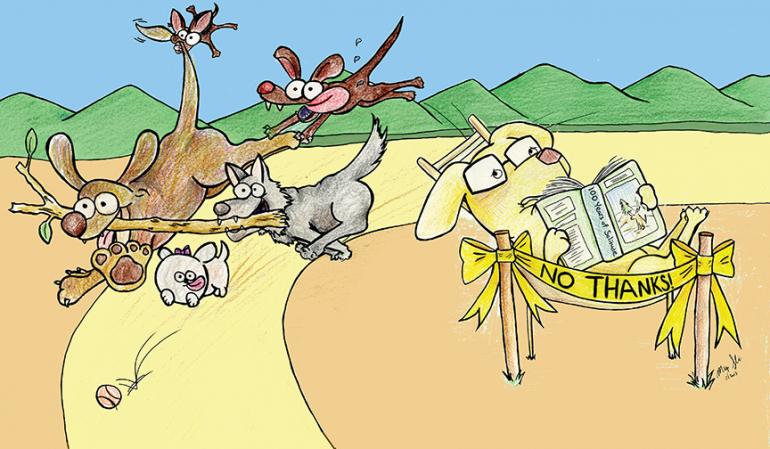Tie a Yellow Ribbon
Most of our outdoor adventures are enhanced with a canine companion, and options for dog-friendly recreation seem limitless. A well-intentioned owner can take a dog for a run around Peets Hill, a hike up Triple Tree, or a swim at the Bozeman Pond. But as dog numbers increase and recreation areas stay the same size, confrontation is bound to increase as well. Depending on the personality of the dog, innocent outings with a four-legged pal can quickly turn into growls and bared teeth—or worse.
The Yellow Dog Project thinks it has the answer: a ribbon marking dogs that need to be left alone. This relatively new program was created as a way for owners of less-social dogs to let other folks know to give them some space. It’s taking off in multiple countries as a way to cut down on unwanted dog-to-dog interaction and the ensuing unpleasantness.
Most Bozeman dogs get along splendidly with their humans, but many don’t appreciate an endless barrage of friend requests from every other pooch at the park. There are a variety of reasons why an owner might choose to tie a yellow ribbon on a dog’s leash: it might be recovering from an injury, be in training, or simply lack the personality that appreciates a bombardment of sniffs, licks, and other general annoyances.
With an ever-increasing number of owners on board, the Yellow Dog Project has the potential to cut down on aggressive encounters—but is it creating limitations on dogs and their innate interactions? Every species of animal has evolved with an intricate language that has never needed human words or symbolism. On its most basic level, canine body language can be understood by dogs and people alike. A stiff body, raised hackles, and flattened ears say, “leave me alone.” (You don’t have to be Cesar Milan to figure that one out.) Which begs the question: is the yellow ribbon interfering with the natural order of things?
Critics point out that the responsibility of dog ownership swings both ways. If your dog has shown aggressive tendencies, work on socializing him. Take him to training classes, where he can learn to interact with other dogs in a safe, controlled environment. Conversely, if your pooch runs up to befriend everyone in the park, teach him to back off. A ribbon marking your dog as hands-off shifts the burden from you onto everyone else.
Additionally, while keeping one’s friendly dog away from a ribbon-clad pup might prevent an unpleasant encounter, if he’s always being restrained, he’ll never learn the values of personal space. On the other end, yellow ribbons might prevent a shy dog from experiencing interactions that progress its social skills. It’s a fine line, though—while the majority of doggie greetings never turn sour, there’s always the chance of a friendly hello turning negative with potentially serious consequences.
There are larger issues at work here. By domesticating animals, we attempt to corral them into human social parameters. We’ve been keeping animals as pets and ingratiating them into our homes for centuries, and as much as we’d like to keep things natural, adjustments have to be made to ensure a safe environment for all involved.
In the end, the jury’s still out. Thumbs up to giving Yellow Ribbon dogs their space, or thumbs down to making dog owners lazy and refusing to correct their dog’s social anxieties? Either way, check out theyellowdogproject.com for more info on the program. As always, you can let us know what you think at outsidebozeman.com/magazine.










